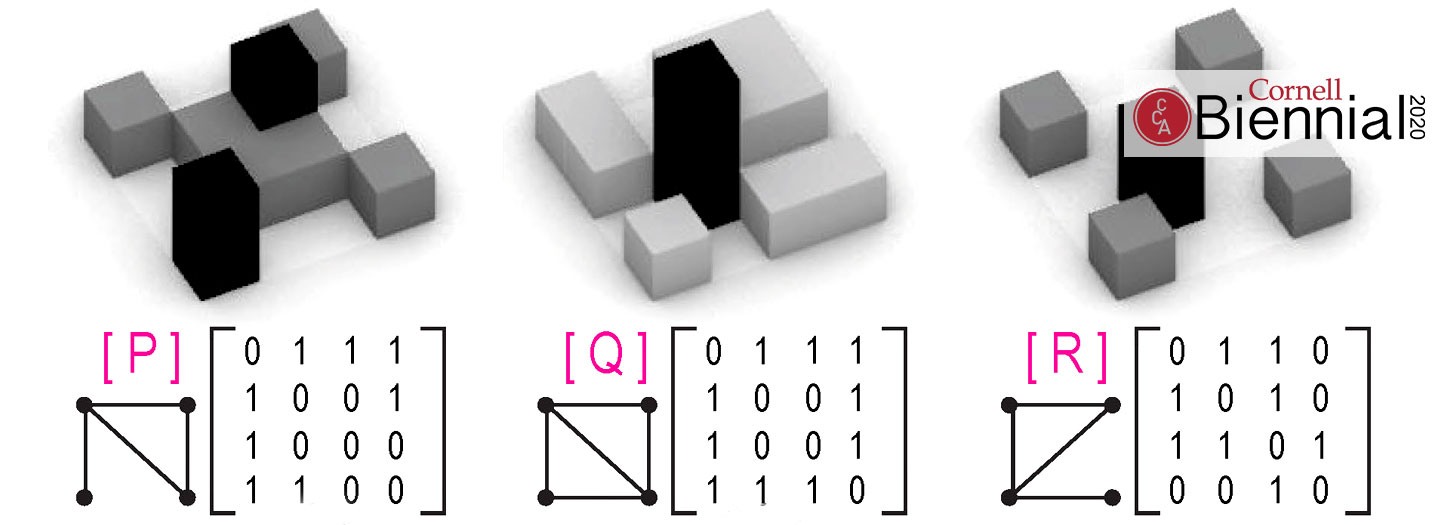
MENGNI ZHANG
In Touch
A Tactile Language Encoder
Nature has proven to us through evolution that by organizing weak and uninformed individuals into a swarm, the collective whole is capable of extending beyond the knowledge of individuals and taking on complex tasks that guarantees the survival of the species. Without words or spoken languages, a swarm can successfully communicate and self-organize through rule-based collective intelligence and emergent behaviors. This project aims to create a language digitization process that utilizes the tactile senses of a person to produce a physical object that enables communication among people with visual, auditory and speech disabilities, or physical distancing. Swarm in this project is manifested through and enabled by an artificially constructed encoder, which serves as a translator of meaning and creator of a new pictogram-like language. We will demonstrate the encoding process and then move on to exploring using it as a new media to materialize abstract and ephemeral concept into physical object that one can hold in their hands or feel its volume, and by the very act of holding or observing can understand the content it carries through practice.
Within the framework of swarm, what the device generates could also be anti-swarm: the message encoding and decoding process is a centralized one carried out by the users alone based on deterministic algorithm. The algorithm, or a set of local rules governing individual to individual interaction lies at the heart of the swarm mechanism, without which the entire colony will descend into a precarious state of chaos. Therefore, the creation of an alphabet encoding algorithm is at the core of this project. We want to look beyond the façade of the swarm pattern, and explore deeper into the logic behind the apparent behavior to draw the connection at a more fundamental level. This is done by constructing a matrix based on the human hand (considered here as 4×4) and encode each cell with a 0 or 1 value to form a unique pattern. This pattern will be used to determine the extrusion heights of the physical artifacts’ four sides. Each artifact carries a complete meaning of a phrase, as such, it abandons the traditional linear fashion of language processing.
Verbal communication would be forbidden in the physical exhibition gallery. This introduces a level of insecurity and precarity as seen in nature, which will force visitors to adapt and solve by seeking alternative means of interaction (by learning to encode messages), simulating a situation that human communication evolves to foster and acquire emotional bonds under environmental changes. Prone to human error and data loss, this digitally mediated social interaction on many levels (physical barrier to digital barrier) may lead to misreading of social sympathy once data entanglement happens, causing a deviation from the established collective awareness and mutual understanding of messages. Therefore, in this work, given the opportunity for precarity from users, the mis-interpretation of message can lend to new formation of artifact creation and twisting the exhibit’s intention from a rigidly defined process into a fluid reactive performance.
- April 1-30, 2021
- DEA Gallery
1st Floor MVR Gallery
Mengni Zhang ( ) & Ruixuan Li ( )
Mengni Zhang is a multi-disciplinary designer with a background in architecture. His design and research interests span from healthcare architecture to sensor based interactive installations. Professionally, Zhang has been practicing architecture for five years, designing hospitals and medical campuses in various countries. He has received various awards including a group Honorable Mention in UIA-PHG’s future hospital design competition; an Honorable Mention in Evolo Magazine’s skyscraper competition; an Honor Award in AIA DC’s Washington Unbuilt competition. Zhang holds a Bachelor’s degree in Architecture from Cornell University and a Master’s degree in Design Studies with a concentration in urban resilience from Harvard University. He is currently a PhD student in Human Behavior and Design at Cornell University.
Ruixuan Li is an independent curator and writer. She contributed to and co-curated multiple exhibitions and public events for art organizations in the San Francisco Bay Area. Her articles also appear in The Art Newspaper China and Artco China, etc. In 2019, she participated in the 2019 Bi-City Biennale of Urbanism\Architecture (Shenzhen) and a joint residency project by Gazetteer-Novel and SallyProject with her works The Foolish Old Man Project and Lychee Tower. In 2020, her tabletop role-playing game The Enigmas at Red Point derived from the flash fiction that she wrote in Red Hook, Brooklyn received fiscal sponsorship by New York Foundation for the Arts (NYFA).